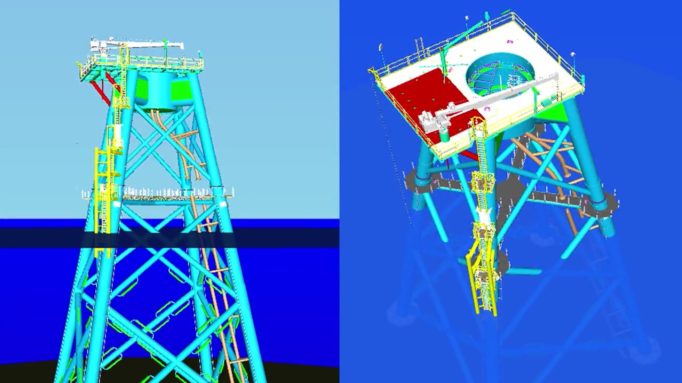As part of the USD 290 million Block Island Wind Farm project to supply less expensive power to Rhode Island and New England, Keystone Engineering (Keystone) was retained to design the substructures for five, 6-megawatt wind turbine generators. To accommodate the complex aerodynamic and hydrodynamic loading of the deep water wind turbines and streamline communication with the generator designer, Keystone needed flexible, interoperable offshore design and analysis tools.
Keystone leveraged Bentley SACS to adapt steel jacket foundations used in the oil and gas industry as the design for the deep-water wind turbine support structures. SACS enabled Keystone to design the composite construction and complex nodal geometry for the jacket substructures, delivering an alternative to typical offshore wind monopile concrete foundations that are limited to more shallow water depths. Keystone relied on the SACS functionality to interface with GH Bladed software used by the turbine generator designer to optimize the design of the total structure and ensure safe operation.

Using Bentley software, Keystone was able to reduce design cycle by 50%, save on 15% on steel and 20% on installation costs.
Using Bentley SACS for its jacket design process enabled Keystone to optimize the amount of steel needed for the sub-structure, reducing installation costs by over 20 percent compared to traditional monopile construction. Bentley SACS also allowed Keystone to perform, in parallel, multiple simulations, and numerous design iterations, shortening the design cycle by 50 percent. Keystone’s innovative design mitigated risk and reduced fabrication and installation costs. Bentley’s comprehensive, interoperable software ensured effective collaboration with the wind turbine designers, facilitating accurate modeling throughout the project.
Using SACS, Keystone performed over 3,000 time-domain simulations for each design iteration, and conducted over 150 simulations in parallel, reducing cycle time by 50 percent as compared to typical European offshore wind projects. The interoperability of SACS with GH Bladed software enhanced the team’s ability to tune the frequency of the structures for optimal operation within a wide band of wind speeds and oceanographic conditions to maximize revenue. Bentley SACS enabled Keystone to streamline design and analysis, reduce costs, and accurately manage the terabytes of project data, minimizing the possibility for errors.
For more information, visit http://bentley.com
